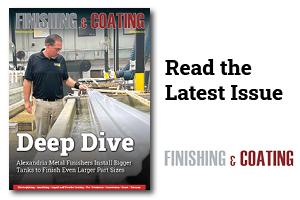Dennis Capoccia has attended dozens of industry trade shows over the past few years, none organized by the industry he works in.
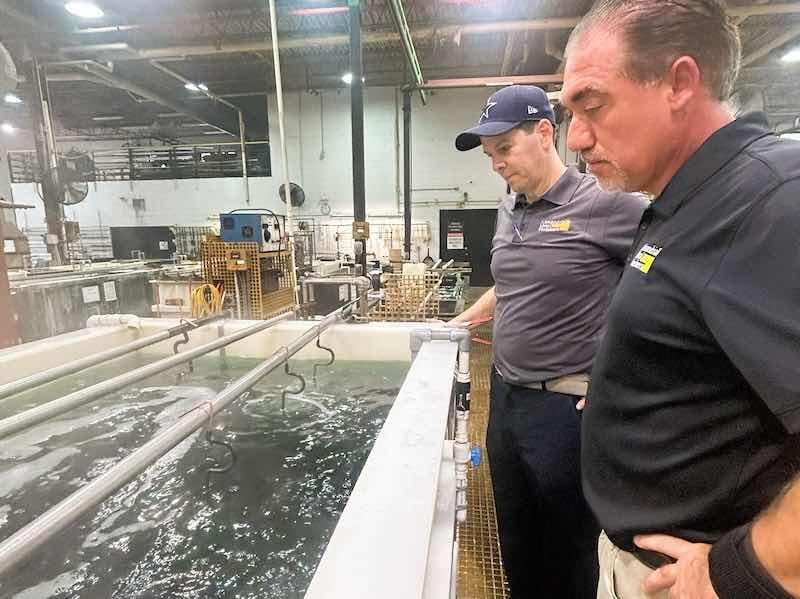 Alexandria Metal Finishers Plant Manager Dennis Capoccia, right, checks over the new tanks ans equipment that the company installed recently.The Plant Manager of Alexandria Metal Finishers in Lorton, Virginia, says it makes good business sense not to attend only shows where all other finishers go but to target specific manufacturing and innovation events where he can meet potential customers.
Alexandria Metal Finishers Plant Manager Dennis Capoccia, right, checks over the new tanks ans equipment that the company installed recently.The Plant Manager of Alexandria Metal Finishers in Lorton, Virginia, says it makes good business sense not to attend only shows where all other finishers go but to target specific manufacturing and innovation events where he can meet potential customers.
“They tell us a little bit about what's going to happen in the future — or what they think will happen — and then we can adjust to that,” says Dennis, whose company is about 30 minutes from Washington, D.C., where many trade shows occur. Since January, Dennis and the Alexandria Metal Finishers team have attended numerous industry shows and trade events, often the only finishers in a room full of other manufacturers and innovators.
“We tell everybody that we can't do everybody's work, but we just want to be another source,” he says. “It's more about learning what's going on out there. I like talking to people and seeing what's changing in the market. When I see industry veterans out there, those are the people I want to speak to because they usually have a pretty good understanding of what's happening in the market.”
“As the demand for larger parts kept increasing, I realized we needed to improve our lines and add larger tanks. This highlighted the importance of a facility redesign.”
“I still go knock on doors,” he says. “I still go to see new and current customers. I'll take a day off maybe once every 2-3 weeks, and I try to visit customers we have now. I still see them, and I think it's different from an email or text message. Sometimes it works out, sometimes not as well.”
Founded in 1962 with Over 40 Processes
 Dennis Capoccia learned much about the plating industry from his father, Loreto “Larry” Capoccia, one of the most knowledgeable finishers in the industry.Alexandria Metal Finishers was founded in 1962 and provides metal finishing services to the aerospace, telecommunications, electronics, medical, packaging, defense, and commercial industries. They offer more than 40 processes, including non-destructive testing, and maintain an in-house library of federal, aerospace, military, and commercial standards.
Dennis Capoccia learned much about the plating industry from his father, Loreto “Larry” Capoccia, one of the most knowledgeable finishers in the industry.Alexandria Metal Finishers was founded in 1962 and provides metal finishing services to the aerospace, telecommunications, electronics, medical, packaging, defense, and commercial industries. They offer more than 40 processes, including non-destructive testing, and maintain an in-house library of federal, aerospace, military, and commercial standards.
Growing up, he worked alongside his father, Loreto “Larry” Capoccia, and Dennis Capoccia has amassed over 36 years of experience in the metal finishing industry. Throughout his career, he has navigated and adapted to the industry's progression, continuously expanding the capabilities of Alexandria Metal Finishers.
“For the first few years, I worked in the plating department, learning a great deal from highly experienced platers,” Dennis says. “As the demand for larger parts kept increasing, I realized we needed to improve our lines and add larger tanks. This highlighted the importance of a facility redesign.”
Recently, Dennis and his team installed six electroless nickel tanks for daily operations to reduce downtime and increase productivity.
“When I started, we didn't have the capacity to handle parts longer than 8 feet,” he says. “We expanded our capacity significantly, upgrading from a single Type II 8-foot tank to three Type II tanks, with the largest being 20 feet long. Similarly, we went from two 8-foot hardcoat tanks to three hardcoat tanks, with the largest measuring 16 feet in length.”
As a Nadcap-approved facility, Alexandria Metal Finishers recently expanded its capabilities with deeper anodizing tanks that now reach 60 inches in depth for Type III processes, allowing them to provide larger anodized finishes suitable for various industries, especially aerospace and defense. Their tank capacities include:
- Type II Clear Capacity: up to 20 feet in length and 48 inches in depth.
- Type II Black Capacity: up to 20 feet long and 48 inches deep.
- Type III Hard Coat Capacity: up to 16 feet in length and 60 inches in depth.
- Type III Hard Coat Black Capacity: up to 16 feet in length and 60 inches in depth.
“It seems like every time you put in a line, you find out later that you are a few inches short here or there,” Dennis says. “We are starting to redesign all the anodized lines for larger capacity. We started with 8-foot tanks when we added anodizing 20 years ago, but we quickly saw that 8 feet wasn't good enough. So we went to 10 feet, and now 10 feet isn't good enough.”
“I always want to ensure I'm never down, and it doesn't affect the customer regarding delivery.”
Now that they have expanded to 16 and 20 feet on some lines, they are also adding cranes to help with larger parts, including handrails and anything they get from aerospace and defense.
“We always say ‘pocket size to rocket size,’” Dennis says. “And knowing I've just done this, I'm sure I'll get a quote at 22 feet.”
Keeping Systems Up-to-Date to Meet Demands
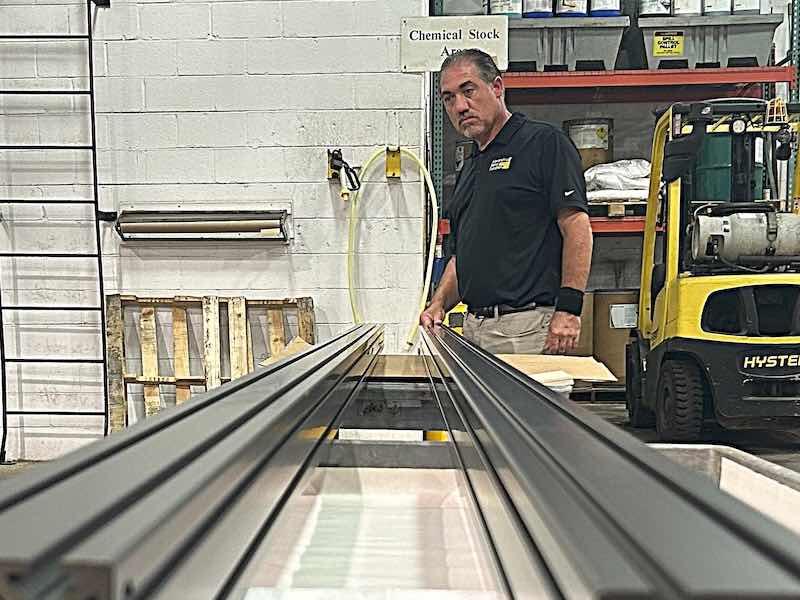 Alexandria Metal Finishers recently expanded its capabilities with deeper anodizing tanks that now reach 60 inches in depth for Type III processes.Alexandria Metal Finishers had the tanks built by a fabricator, but their team installed them just to their liking and with the ability to add flexibility to the lines. They almost constantly have three hardcoat tanks working at all times and three Type II lines running, so they are always planning for contingencies.
Alexandria Metal Finishers recently expanded its capabilities with deeper anodizing tanks that now reach 60 inches in depth for Type III processes.Alexandria Metal Finishers had the tanks built by a fabricator, but their team installed them just to their liking and with the ability to add flexibility to the lines. They almost constantly have three hardcoat tanks working at all times and three Type II lines running, so they are always planning for contingencies.
“You never know when a chiller goes out, and you must have another backup,” Dennis says. “I always want to ensure I'm never down, and it doesn't affect the customer regarding delivery.”
In addition, Alexandria Metal Finishers increased its dyed anodizing capabilities to offer more than just black anodizing up to 16 feet. They now provide various dyed anodizing colors in various sizes, including red, fiery red, blue, green, violet, orange, gold, grey, and olive drab.
“All the colors we have are already set up, so we don't set them up as needed,” Dennis says. “They're always set up and temperature controlled. The mindset is that whenever the customer calls, we analyze the bath and are ready to go. I don't have to mix it every time.”
Alexandria Metal Finishers also runs six electroless nickel lines most days as an undercoat for most of the projects they are working on, and Dennis says they are adding a new EN line to augment — and back up — their existing processes.
“We're slowly trying to upgrade the building and the facility as needed,” he says.
'Great Team, Great Lab, and Great Quality'
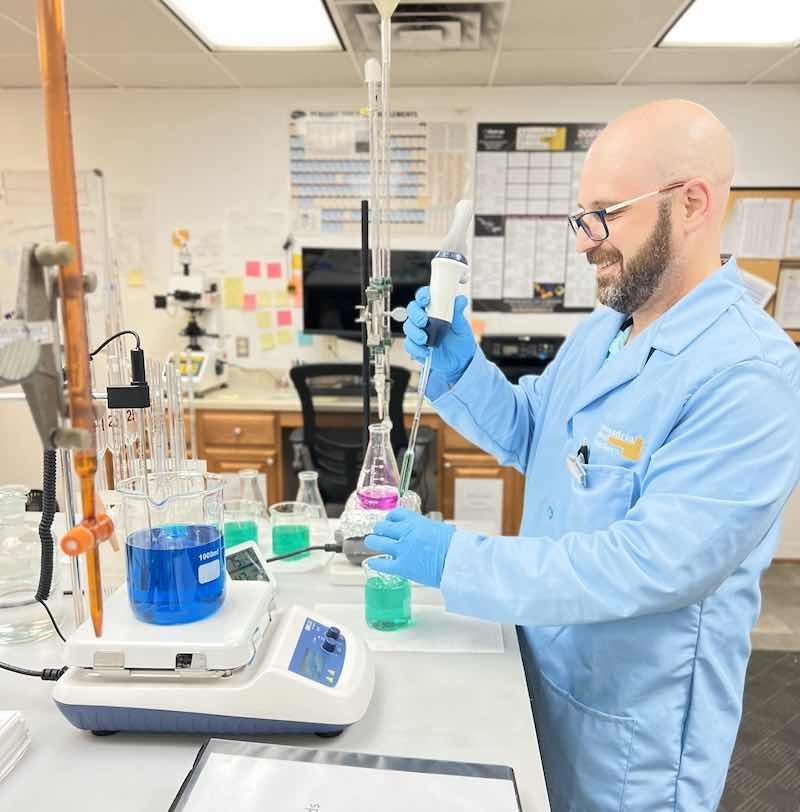 Alexandria Metal Finishers was founded in 1962. Soon after, an Italian immigrant joined the company when Dennis’s father, Larry, began his career in the finishing industry. Larry eventually became one of the owners of Alexandria Metal Finishers and gave back to the industry by serving as secretary, vice president, and president of the AESF Baltimore-Washington chapter. More than 50 years later, Larry works daily in the AMF offices.
Alexandria Metal Finishers was founded in 1962. Soon after, an Italian immigrant joined the company when Dennis’s father, Larry, began his career in the finishing industry. Larry eventually became one of the owners of Alexandria Metal Finishers and gave back to the industry by serving as secretary, vice president, and president of the AESF Baltimore-Washington chapter. More than 50 years later, Larry works daily in the AMF offices.
“I like to say we have a great team here,” Dennis says. “We have great people at the shop, good quality control, and a great lab. Running things properly involves having a great staff, especially with the Nadcap requirements.”
Alexandria Metal Finishers made a huge name for itself—thanks to its proximity to Washington, D.C.—by working closely with the National Archives to coat several frame parts of the Charters of Freedom, the three documents in early United States history that are considered instrumental to its founding and philosophy: the United States Declaration of Independence, the Constitution, and the Bill of Rights.
Alexandria Metal Finishers coated the document platforms on which the documents rest with black anodizing. The specially milled platforms also include a NIST-integrated instrument system that monitors conditions inside, such as humidity and the argon gas level, keeping the pages from drying out. This, in combination with specially coated and placed metal seals, protects the documents from the outside environment.
“We've done some cool stuff, and a lot of the things that we've done, we don't know where they go,” Dennis says. “But we are very proud to be a part of everything we do.”
The facility then gold-plated the one-piece titanium frames, which required a specially engineered setup to fit the frames and reduce gold waste. Gold was chosen to accentuate the bronze used throughout the rest of the dome during the renovation aesthetically. The effect of the black anodizing offset by the gold plating is such that the documents appear as though they are floating within their frames.
In addition, Alexandria Metal Finishers was selected to participate in the renovations of the Washington Monument and gold-plated the nearly 30-foot copper lightning rods surrounding the monument's pyramid.
 Alexandria Metal Finishers made a huge name for itself—thanks to its proximity to Washington, D.C.—by working closely with the National Archives to coat several frame parts of the Charters of Freedom, the three documents in early United States history that are considered instrumental to its founding and philosophy: the United States Declaration of Independence, the Constitution, and the Bill of Rights.
Alexandria Metal Finishers made a huge name for itself—thanks to its proximity to Washington, D.C.—by working closely with the National Archives to coat several frame parts of the Charters of Freedom, the three documents in early United States history that are considered instrumental to its founding and philosophy: the United States Declaration of Independence, the Constitution, and the Bill of Rights.
Called Upon to Plate Unique Projects
 Dennis says Alexandria Metal Finishers is also occasionally called to finish unique components that later turn out to be used in notable projects. For example, they worked with the National Geographic Society's Exploration Technology Lab on their Crittercams, special cameras attached to animals play a crucial role in providing valuable insights and a deeper understanding of wildlife and their environments.
Dennis says Alexandria Metal Finishers is also occasionally called to finish unique components that later turn out to be used in notable projects. For example, they worked with the National Geographic Society's Exploration Technology Lab on their Crittercams, special cameras attached to animals play a crucial role in providing valuable insights and a deeper understanding of wildlife and their environments.
The Crittercam gathers audio, video, and environmental sensor data that provides detailed information on behavior that other instruments or human observers cannot provide for animals, including lions, humpback whales, African elephants, Tasmanian devils, and green sea turtles, to name a few.
Alexandria Metal Finishers also went Hollywood when it partnered with the Naval Air Warfare Center Aircraft Division’s camera enclosures attached to the F-18 aircraft utilized in the Tom Cruise-starring movie Top Gun: Maverick. The cameras ensured every breathtaking moment was captured with precision and clarity, with four enclosures mounted on the designated shooting jet for exterior shots, including two under the belly of the F-18, one under the wing, and one on the nose.
Every year, Alexandria Metal Finishers works with Michael Dunlap Studio to gold-plate NASCAR’s Goodyear Gold Car, one of the sport’s most coveted awards. Since 1985, Goodyear has awarded the Cup Series champion a 24-karat gold-plated replica of their actual race car.
“We've done some cool stuff, and a lot of the things that we've done, we don't know where they go,” Dennis says. “But we are very proud to be a part of everything we do.”
Open Door for Customer Site Surveys
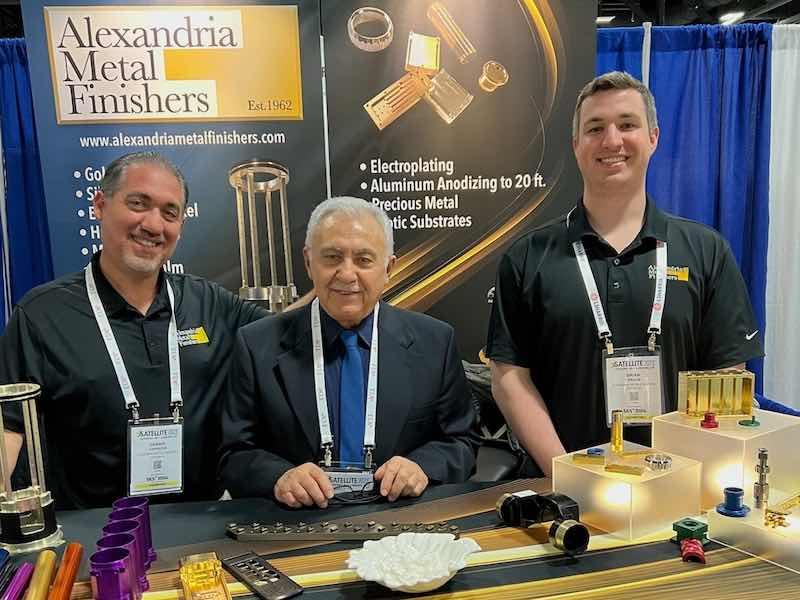 The Alexandria Metal Finishers team says it makes good business sense not to attend only shows where all other finishers go but to target specific manufacturing and innovation events where he can meet potential customers.With the newer tanks that provide them with more size options, Dennis says Alexandria Metal Finishers is working to keep up with market demands. That often includes the need to continually spend money on finishing operations to give customers what they want.
The Alexandria Metal Finishers team says it makes good business sense not to attend only shows where all other finishers go but to target specific manufacturing and innovation events where he can meet potential customers.With the newer tanks that provide them with more size options, Dennis says Alexandria Metal Finishers is working to keep up with market demands. That often includes the need to continually spend money on finishing operations to give customers what they want.
Dennis says manufacturers seeking additional platers to work with should visit the shop and see what they have upgraded and what they plan to add in the future.
“I invite everybody to do a site survey,” he says. “Everybody has a speech, but whomever you're going to use, do a site survey or look at their lab. Look at their quality control. Then you can see where your money's going.”
Alexandria Metal Finishers will continue to seek out those unique projects that other shops may have turned down because of the complexity, but those are the ones they enjoy doing the most.
“A lot of the parts become very complicated, and we focus more on some of those parts, especially masking and other requirements there,” Dennis says. “But I joke with all the customers and tell them, ‘Hey, how about giving me something easy every once in a while? Give the other guy the hard stuff.’ But they know that is what we are good at.”






